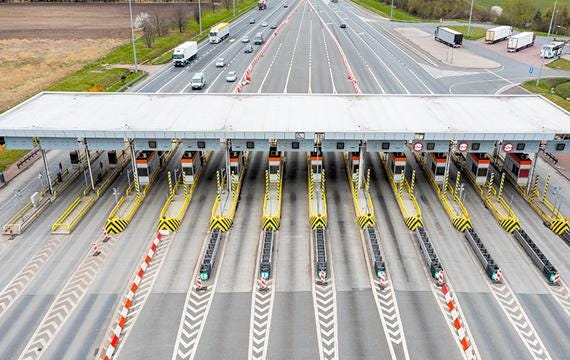Electronic Toll Collection Market Size, Share, Trends, Growth and Forecast 2030

The Electronic Toll Collection (ETC) Market refers to the systems and technologies used to automate toll collection on roads, bridges, and tunnels, eliminating the need for physical stops at toll booths. These systems improve traffic flow, reduce congestion, and minimize the environmental impact by reducing idle time at tolls. ETC systems use various technologies such as radio-frequency identification (RFID), dedicated short-range communications (DSRC), global positioning systems (GPS), and video tolling to electronically collect toll payments.

Get a Free Sample : https://www.zionmarketresearch.com/sample/electronic-toll-collection-market
Key Components of Electronic Toll Collection Systems:
- Transponders/Tags: Small electronic devices installed in vehicles that communicate with roadside toll systems. RFID and DSRC are the most common technologies used.
- Antenna Systems: These detect the transponders in vehicles and collect the necessary toll data as vehicles pass through toll points.
- Cameras and Sensors: Used for image and video-based tolling, these devices capture license plates and vehicle information for payment processing (usually when a vehicle doesn’t have a transponder).
- Centralized Software Platforms: These systems process toll transactions, manage accounts, and handle billing, including customer service and violation processing.
- Toll Gates and Barriers (Optional): Some systems still include physical barriers, though fully automated, barrier-free systems are increasingly common.
Market Drivers:
- Traffic Congestion and Urbanization: Growing urban populations and increased vehicle numbers are driving the need for more efficient toll systems to manage traffic congestion.
- Government Initiatives for Smart Infrastructure: Governments worldwide are investing in intelligent transportation systems (ITS), which include electronic toll collection as part of broader smart city initiatives.
- Environmental Concerns: Reducing vehicle emissions by minimizing stops at toll booths and improving fuel efficiency are key motivations for implementing ETC systems.
- Cost Efficiency and Revenue Collection: ETC systems help toll operators reduce labor costs, increase toll collection accuracy, and minimize toll revenue leakage or fraud.
Market Segmentation:
- By Technology:
- RFID: Uses radio waves to communicate between a transponder and the toll system. This is one of the most commonly used technologies, especially in North America and Asia.
- Dedicated Short-Range Communications (DSRC): Widely used in Europe and Japan, DSRC enables fast, secure, and accurate tolling transactions.
- Global Positioning System (GPS): Used in free-flow or distance-based tolling, GPS tracks vehicle locations to determine tolls based on road usage.
- Video Tolling/Automatic Number Plate Recognition (ANPR): Uses cameras to capture license plates for tolling, especially when transponders are absent.
- By Application:
- Highways: ETC systems are widely used on highways to manage long-distance traffic and reduce congestion at toll plazas.
- Urban Areas: Congestion pricing and urban tolling are common in cities to manage traffic during peak hours.
- Bridges and Tunnels: Tolling for specific infrastructure projects, especially where toll revenue is used for maintenance and construction funding.
- By Deployment Model:
- On-Premise: Traditional systems where the infrastructure is managed and maintained by toll operators on-site.
- Cloud-Based: Emerging cloud-based tolling systems that offer more flexibility, scalability, and reduced infrastructure costs.
Major Players in the Market:
- Kapsch TrafficCom AG — A leading provider of intelligent transportation systems, including electronic toll collection.
- TransCore — Known for its DSRC-based toll collection systems, widely used in the U.S.
- Cubic Transportation Systems — Specializes in both urban and highway tolling systems.
- Toll Collect GmbH — A major player in distance-based tolling systems in Europe.
- Conduent Inc. — A global provider of automated tolling solutions and public sector transport technologies.
- Siemens AG — A key player in transportation solutions, including tolling and road management technologies.
Market Trends:
- Interoperability: As tolling becomes more widespread, especially across multiple regions and countries, the demand for interoperable toll systems is growing. Interoperability allows a single transponder or payment method to work across different toll systems.
- GPS and Distance-Based Tolling: Distance-based tolling, which calculates tolls based on the number of miles driven rather than toll booths, is gaining popularity in Europe and North America.
- Congestion Pricing: Cities are adopting congestion pricing systems, where drivers pay tolls based on the time of day or traffic conditions, to reduce traffic in high-density areas.
- Cashless and Contactless Payments: With increasing focus on convenience and hygiene (accelerated by the COVID-19 pandemic), ETC systems are increasingly moving toward completely cashless and contactless payment methods.
- Electric Vehicle (EV) Incentives: Some regions are integrating toll discounts or exemptions for electric vehicles to promote cleaner transportation.
Challenges:
- High Initial Investment: The infrastructure required for fully automated toll systems can be expensive, especially for developing countries or smaller municipalities.
- Data Privacy Concerns: As ETC systems gather large amounts of vehicle and user data, there are increasing concerns over privacy and data security.
- Technological Integration: Different countries and regions often have varying standards for toll collection technology, making it difficult to create seamless cross-border systems.
Regional Insights:
- North America: The U.S. and Canada are major markets, driven by the widespread adoption of RFID-based systems like E-ZPass. Interoperability and distance-based tolling are gaining traction.
- Europe: Europe is a leader in DSRC-based systems and distance-based tolling, with countries like Germany and France implementing nationwide systems.
- Asia-Pacific: Rapid urbanization, increasing vehicle ownership, and government investments in smart city projects are driving growth in countries like China, India, and Japan.
- Middle East & Africa: Emerging markets with increasing road infrastructure development and interest in smart transportation solutions.
Directly Purchase a copy of the report with TOC :
Market Size and Growth:
The global ETC market is valued in the billions and is expected to grow at a compound annual growth rate (CAGR) in the high single digits over the next five years. Growth is driven by urbanization, increasing vehicle ownership, and government initiatives to modernize transportation infrastructure.
Contact Us:
Zion Market Research
USA/Canada Toll Free: 1 (855) 465–4651
Newark: 1 (302) 444–0166
Web: https://www.zionmarketresearch.com/
Blog: https://zmrblog.com/
read other reports :
https://www.zionmarketresearch.com/report/rfid-portals-for-doorways-corridors-market
https://www.zionmarketresearch.com/report/low-voc-adhesives-market
https://www.zionmarketresearch.com/report/fertility-testing-devices-market
https://www.zionmarketresearch.com/report/advanced-visualization-market
https://www.zionmarketresearch.com/report/automotive-seat-belts-market
Comments
Post a Comment